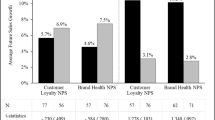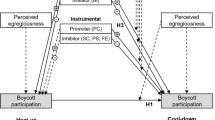Abstract
The disposition effect refers to the tendency of financial consumers to sell winning assets (e.g., stocks) too early and to hold losing assets for too long. This effect implies that investors behave asymmetrically under the conditions of paper gains and losses. Although prior research on the disposition effect drew primarily on prospect theory as the explanatory mechanism, we focus on regulatory focus, an alternative mechanism. Regulatory focus theory suggests that people pay distinctive attention to profits and losses depending on self-regulation orientations (i.e., promotion focus vs. prevention focus). We argue that regulatory focus has different influences on financial consumers’ investment behavior in the gain and loss domains. In three experimental studies, we demonstrate that regulatory focus moderates the disposition effect. The results of the current studies imply that the disposition effect is primarily driven by prevention- (vs. promotion-) focused individuals who behave asymmetrically in the gain and loss domains.

Similar content being viewed by others
References
Ammann, M., Ising, A., & Kessler, S. (2012). Disposition effect and mutual fund performance. Applied Financial Economics, 22(1), 1–19.
Brown, P., Chappel, N., Da Silva Rosa, R., & Walter, T. (2006). The reach of the disposition effect: large sample evidence across investor classes. International Review of Finance, 6(1–2), 43–78.
Chernev, A. (2004). Goal orientation and consumer preference for the status quo. Journal of Consumer Research, 31(3), 567–565.
Crowe, E., & Higgins, E. T. (1997). Regulatory focus and strategic inclinations: promotion and prevention in decision making. Organizational Behavior and Human Decision Processes, 69(2), 117–132.
Dhar, R., & Zhu, N. (2006). Up close and personal: investor sophistication and the disposition effect. Management Science, 52(5), 726–740.
Fogel, S. O., & Berry, T. (2006). The disposition effect and individual investor decisions: the role of regret and counterfactual alternatives. Journal of Behavioral Finance, 7(2), 107–116.
Garvey, R., & Murphy, A. (2004). Are professional traders too slow to realize their losses? Financial Analysts, 60(4), 35–43.
Grinblatt, M., & Keloharju, M. (2001). What makes investors trade. Journal of Finance, 56(2), 589–616.
Hayes, A. F., & Matthes, J. (2009). Computational procedures for probing interactions in OLS and logistic regression: SPSS and SAS implementations. Behavior Research Methods, 41(3), 924–936.
Higgins, E. T. (1997). Beyond pleasure and pain. American Psychologist, 52(12), 1280–1300.
Higgins, E. T. (1998). Promotion and prevention: regulatory focus as a motivational principle. In M. P. Zanna (Ed.), Advances in experimental social psychology (vol. 30, pp. 1–46). New York: Academic.
Higgins, E. T., Friedman, R. S., Harlow, R. E., Idson, L. C., Ayduk, O. N., & Taylor, A. (2001). Achievement orientations from subjective histories of success: promotion pride versus prevention pride. European Journal of Social Psychology, 31(1), 3–23.
Idson, L. C., Liberman, N., & Higgins, E. T. (2000). Distinguishing gains from non-losses and losses from non-gains: a regulatory focus perspective on hedonic intensity. Journal Experimental Social Psychology, 36(3), 252–274.
Johnson, J., & Tellis, G. J. (2005). Blowing bubbles: heuristics and biases in the run-up of stock prices. Journal of the Academy of Marketing Science, 33(4), 486–503.
Kahneman, D., & Tversky, A. (1979). Prospect theory: an analysis of decision under risk. Econometrica, 47(2), 263–291.
Kaustia, M. (2010). Prospect theory and the disposition effect. Journal of Financial & Qualitative Analysis, 45(3), 791–812.
Keller, P. A. (2006). Regulatory focus and efficacy of health messages. Journal of Consumer Research, 33(1), 109–114.
Liberman, N., Idson, L. C., Camacho, C. J., & Higgins, E. T. (1999). Promotion and prevention choices between stability and change. Journal of Personality & Social Psychology, 77(6), 1135–1145.
Locke, P. R., & Mann, S. C. (2005). Professional trader discipline and trade disposition. Journal of Financial Economics, 76(2), 401–444.
Molden, D. C., & Hui, C. M. (2011). Promoting de-escalation of commitment: a regulatory-focus perspective on sunk cost. Psychological Science, 22(1), 8–12.
Odean, T. (1998). Are investors reluctant to realize their losses? Journal of Finance, 53(5), 1775–1798.
Oehler, A., Heilmann, K., Läger, V., & Oberländer, M. (2003). Coexistence of disposition investors and momentum traders in stock markets: experimental evidence. Journal of International Financial Markets, Institutions & Money, 13(5), 503–524.
Pham, M. T., & Avnet, T. (2009). Contingent reliance on the affect heuristic as a function of regulatory focus. Organizational Behavior and Human decision Processes, 108(2), 267–278.
Shefrin, H., & Statman, M. (1985). The disposition to sell winners too early and ride losers too long: theory and evidence. Journal of Finance, 40(3), 777–790.
Spiller, S. A., Fitzsimons, G. J., Lynch Jr. G., & McClelland, G. H. (2013). Spotlights, floodlights, and the magic number zero: simple effects tests in moderated regression. Journal of Marketing Research, 50(2), 277–288.
Thaler, R. H. (1999). Mental accounting matters. Journal of Behavioral Decision Making, 12(3), 183–206.
Weber, M., & Camerer, C. F. (1998). The disposition effect in securities trading: an experimental analysis. Journal of Economic Behavior & Organization, 33(2), 167–184.
Weber, M., & Zuchel, H. (2005). How do prior outcomes affect risk attitude? Comparing escalation of commitment and the house-money effect. Decision Analysis, 2(1), 30–43.
Zhou, R., & Pham, M. T. (2004). Promotion and prevention across mental accounts: when financial products dictate consumers’ investment goals. Journal of Consumer Research, 31(1), 125–135.
Author information
Authors and Affiliations
Corresponding author
Additional information
The first author of this article is Young Doo Kim and Young-Won Ha is the corresponding author.
Rights and permissions
About this article
Cite this article
Kim, Y.D., Ha, YW. Who is afraid of disposition of financial assets? The moderating role of regulatory focus in the disposition effect. Mark Lett 27, 159–169 (2016). https://doi.org/10.1007/s11002-014-9323-0
Published:
Issue Date:
DOI: https://doi.org/10.1007/s11002-014-9323-0




